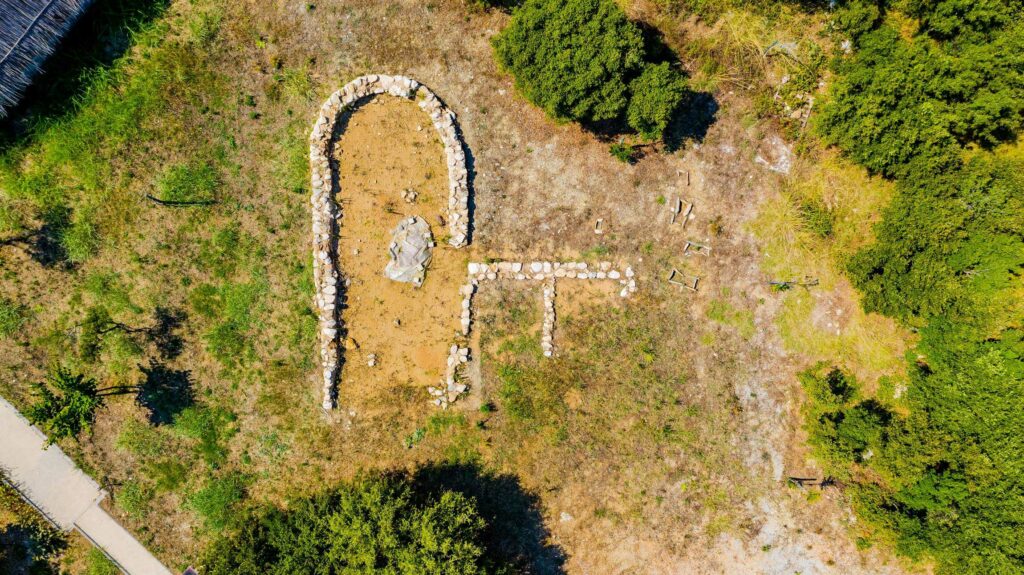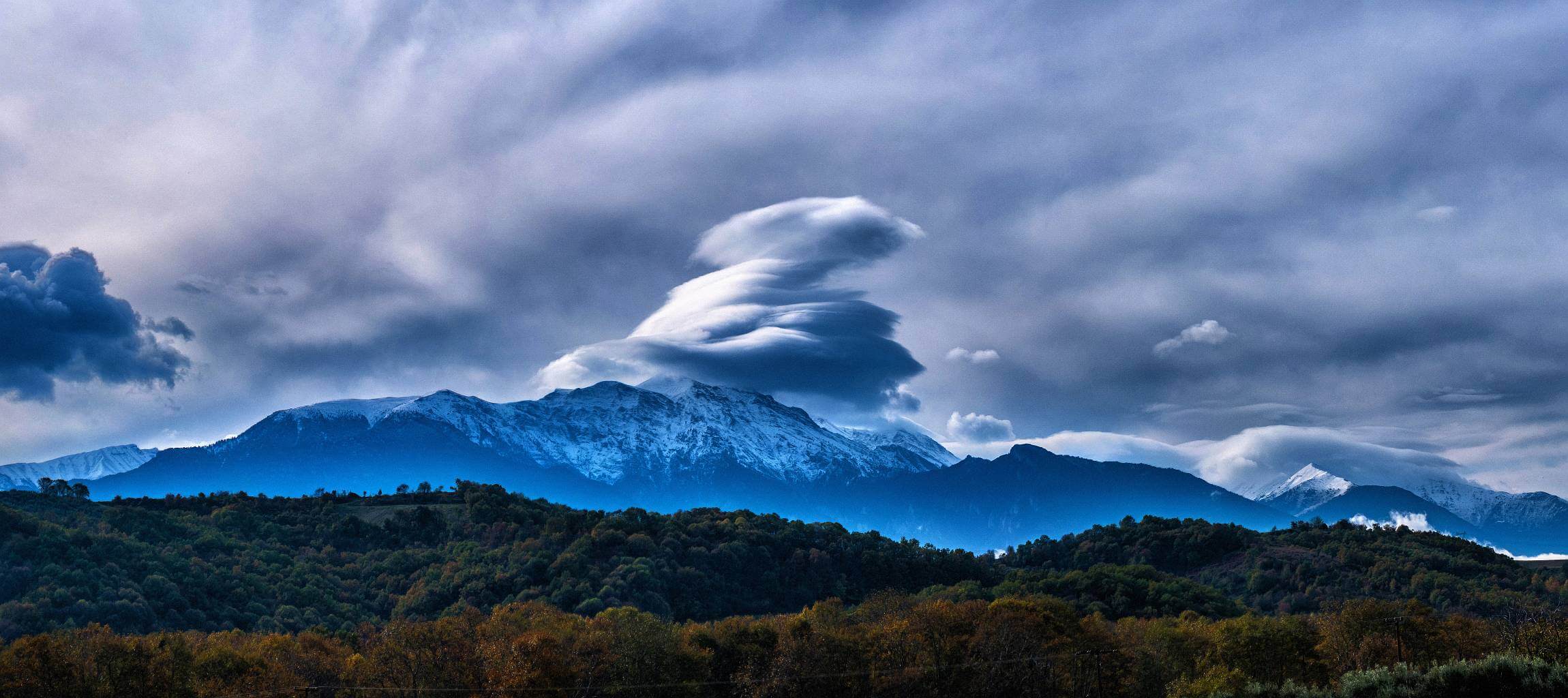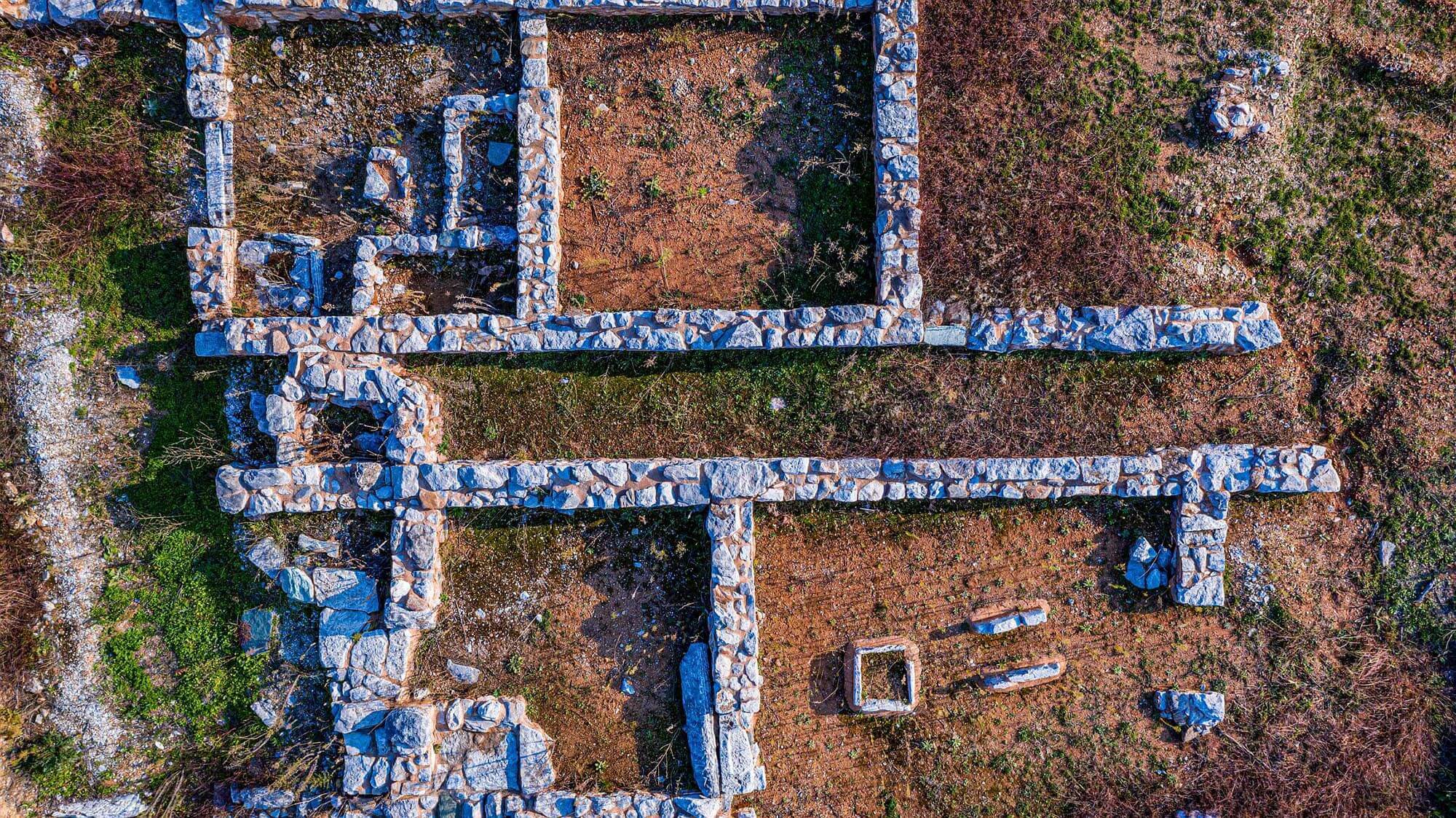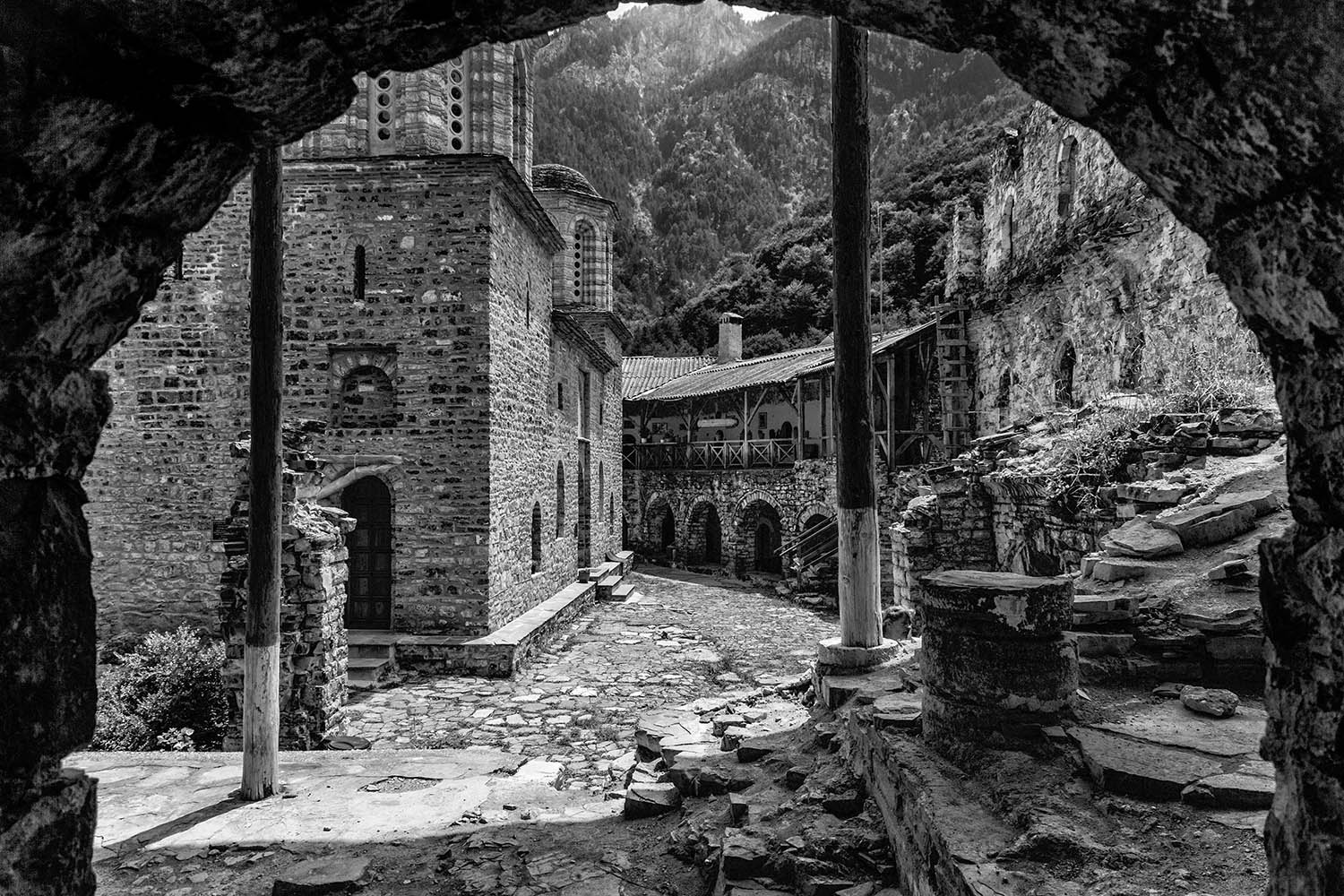MOUNT OLYMPUS
Home » THE MOUNTAIN » History
Since the early prehistoric period, Olympus has been the centre of Greek mythology and philosophy, which attempts to interpret the historical events and represents the exploration of the ancient Greek spirit up to the present. What is more, the holy mountain and the area near it, has been connected with many events that played a decisive role on Greece’s future, from the antiquity to the Second World War.
The first Greek tribes moved from the area of Olympus, where they were located, towards all over the Greek mainland during the 2nd millennium B.C, having the cultural identity, attributed to them during the Mycenean period (end of 2nd mill. B.C.), diffusing the myths for gods and genealogies all over Greece. The first Greek tribes arrived in the area around Olympus in the period between 2300 – 1900 B.C., where they established several settlements and afterwards moved on to southern Greece. One of the Aeolic tribes, Lapithes, made Aenianes- who lived in north-western Thessaly -and Parevi- who lived in the area of Elassona-, retreat to the area of Olympus. Aenianes and Perevoi, having Kyfos as their capital, took part in the Trojan War under the same leader. Perevi spoke aeolic, a dialect spoken by the first Greek tribes, which was formed in Northern Thessaly and Macedonia before 1900 B.C. Aenianes left the olympic area around 1200 B.C and immigrated to Northern Epirus, at the plain of Aoos river.
Pieria, on the north-west side of Olympus, was conquered in about 1200 B.C. by Thracian Pelasgi, who came from eastern regions but were driven back to their old base of operations by Macedonians during their descent to Kato (Lower) Macedonia. Pieres, the first residents of Macedonia, belonged to the first tribes of Thrace, which had been persecuted and later assimilated by Macedonians (8th – 5th B.C centuries). The people who created the settlements around Olympus, at the mid Neolithic Age (4.500 B.C), and especially at the late Copper Age (1500 – 1050 B.C.) and at the Iron Age (1050 – 1000 B.C.) had a developed civilisation and very close trade and cultural relations with southern Greece.
The foot and the slopes of the mythical mountain had been inhabited since the Prehistoric Age, according to the rich archaeological vestiges, which were discovered in the holy mountain. On the eastern side of the mountain there were important towns such as Dion, where there was the glorious sanctuary of Olympus Zeus, Heraklion, close to Platamonas, Livithra, at the gully of Ziliana or Kanales and Pimplia at Enipeas river, close to Litochoro.
On the western side were situated the towns of the Preveric Tripolitida, Azoros, Dolihi and Pythio, with the famous sanctuary of Pythios Apollon. Several settlements of the Neolithic Age were found at the basin of Elassona, whereas the town of the Homeric Elassona (Olooson) is referred by Homer as taking part in the expedition corps of Panellines against Troy.
A cemetery of the late Copper Age was discovered at the north-western woody side of Olympus, at “Spathes” location, which had many box-shaped tombs made of slate from Olympus. The archaeologist Efi Poulaki, who has made research in the area, notes that the excavations at the prehistoric settlement brought to light vessels and jewellery of the Mycenaen era, with clear traces of the southern culture. The remains prove that the narrows of Petra have been, since the Prehistoric Age, a significant passage.
Another cemetery of the Early Iron Age, when the rapid transfers of people – the famous descent of the Doric tribe –took place, was studied by archaeologists, as well as Livithra and Petra. Its tombs were made of stones from the torrents at the foot of the mountain and contained jewels and vessels with an Early Geometrical decorationy

Olympus is strongly related to the Early phase of the history of Macedonians, an early Doric tribe, which has first settled in north-western Thessaly. After the 7th century B.C., Macedonians expanded further on to lower Macedonia and to the area around Olympus, leaded by king Perdikas, the patriarch of Timenides, the royal dynasty which descended from Timenos, the son of Hercules. The mythological relation of Timenides with Heraklides, and the similarity of the archaeological remains of Macedonia with the similar ones in the Peloponnese, evokes, according to the researchers, the close ethnological relations of Macedonians with other Greek tribes. Timenides of Macedonia did not move on southern, whereas Timenides of the Peloponnese descended from the same branch that came from the primary nucleus, from Pindos (Mt. Lakmos or Zygos), which is in central Greece, and together with other ethnological elements they formed the great Greek race of the Doric tribe. The opinion that Heraklides were at the head of the descent of the Doric tribe and that the main Macedonian nucleus was constituted of residents driven away from the city of king Kadmos, Thebes, explains to an extent the common Mycaenic character of the vessels and funeral gifts found in ancient tombs and the existence of a common civilisation in the area of Olympus, at the turn of the first millennium B.C.
Ancient residents of the area of Olympus and all prehistoric people that crossed the famous mountain on their way to southern Greece, considered Olympus as the centre of their religious beliefs, and recognised the twelve gods as protectors and judges. In 1961, on Agios Antonios, one of the highest peaks, during an excavation for the erection of a university observatory, worship relics and archaeological elements of the sanctum of Olympus Zeus were found, thus confirming the ancient historiographical and oral tradition. Epigraphs, fragments of vessels, coins and iron nails proved the existence of the sanctuary of Akreos Zeus on Olympus. Burnt remainings of goatsheeps prove that sacrifices were offered up at the sanctuary of Zeus, in the hope that god will pour rain for their rural cultivation to be fruitful. The peak of Agios Antonios (2.817 m height) had been selected by the ancients for the erection of the sanctuary, because it was flat and more easily accessible compared to the steep higher peak of Mytikas, 100 m higher, where the palace of the gods was located.

The natural and high wall that separated Macedonia from southern Greece, had three main passages through which several invaders, people and troops made their way. One of them was the Pass of Petra, the longest narrow passage in Greece, 33-km long, which is between Olympus and the lower mountain Tataros, and connects northern Thessaly (Perevia) with the Macedonian Pieria. It is through this Pass that the roman army of Aemilius Paulus managed to outflank the army of the king of Macedonia, Perseus, whom he finally defeated in Pydna in 168 B.C., thus subjecting Macedonia, the last free Greek district. General Vrassidas from Sparta, used the same narrows during the war against the Athenians in 424 B.C. as well as the Macedonian king Philip used during his expeditions against southern Greece. In 1912, it was the Greek army that crossed it in its way to free Pieria, during its victorious march to Macedonia.
There are two routes to take when crossing the eastern side of Olympus. One of goes through the plain of Tempi and the second one has the following directions: either- Skotina – Kanalon monastery – Kallipefki – Gonni or Kanalon monastery – Kallithea – Elassona (if you deviate after the monastery), both leading to the Thessalic plain. In 480 B.C. king Xerxis, head of the great Persian army went through the passage of Kanales, went down to Gonni and finally arrived in Athens through Thessaly.
Goths, Slavs, Bulgarians, Franks, Turks and other invaders descended to southern Greece through the passages of Olympus. It was in the Pass of Tempi that took place the last battle of the German army against a troop of New Zealanders of the allied forces, during the German occupation in April 1941.

Olympus, having inaccessible slopes and forests, has been a base of operations for revolutionaries, thieves and rebels and a refuge for those being persecuted and victimised during the frequent foreign occupations of modern Greece. As the historian Ahilleas Lazarou notes, Olympus is the religious and national cradle of Hellenism.
Its high peaks, its hardly accessible stretches of land, remote villages and monasteries became places of freedom and gallantry and were sung by the popular muse. No other mountain of this country has been so strongly related to the Greeks’ freethinking nor has expressed their pride as much as Olympus did. Tens of folk songs refer to the mountain as inaccessible to invaders, celebrate the gallantry of its men, locate it as a place of the free“golden-eagles” and, by the use of allegoric references, establish it as a national symbol of resistance and freedom.
Almost every Greek revolution against the Turkish yoke had Olympus as its starting point, whose inhabitants played a pre-eminent role in national struggles.
Even since the very first years of Turkish occupation, the Turks offered privileges to the unbowed armed fighters of Olympus, providing them with a state of semi – independence, Karamihalis the leading armed fighter. Important armed fighters and thieves emerged from the group of armed fighters of Olympus, like Panos Zidros, Lappas, Lazei, and the legendary Nikotsaras.
The leading men of Olympus raised the flag of revolution at the monastery of Agia Triada, on the 8th March 1822, a revolution that was overwhelmed by blood, as it was the case in the rest of Macedonia. Many Olympic fighters went to southern rebelling Greece and offered their service to the War. A few years later, in 1833, Dimos Tzahilas from Karia incited the thieves of Olympus to rebellion. The army of Emin aga was defeated but the nearby villages of Olympus suffered serious damages, fires and slaughters, by way of reprisal. After the unsuccessful revolution of 1854 on Olympus, important fights take place on the legendary mountain in 1878, leaded by Captain Kosmas Doubiotis and several chieftains from Olympus. What is more, the rebels occupy many villages of Pieria and establish a revolutionary government at Litochoro, the “Temporary Government of Macedonia” with doctor Evangelos Korovagos taking the lead, which claimed from the Great Powers the incorporation of Macedonia in Greece. The powerful Turkish troops reoccupied the freed cities of Pieria, Katerini, Kolindro, Litochoro and destroyed them. Thousands of women and children from Olympus were slaughtered, others sought shelter up the mountains and a few hundreds that were saved were sent to Thessaloniki and put under the protection of foreign consular authorities.
During the Macedonian War, several sections of Macedonian fighters leaded by captain Matapa, Athanasio Broufa and other chieftains incite people to freedom again, while the passages of Olympus, with the co-operation of the local Macedonian fighters, constitute safe passages for the executives of the war, who proceed from free Greece to Macedonia.
The “Richter Affair” is very characteristic of this national alertness and fighting spirit. When the German engineer and climber Edward Richter attempted to climb on Olympus in the summer of 1911, the brigand gang of Giorgos Liolios arrested him and asked for heavy ransom from the Turkish government in order to free him. It was later proved that Liolios co-operated in this kidnapping with the Greek services, so as to upgrade the Greek position in the Balkans and in order to show to the foreign powers that Turkey cannot guarantee security at the occupied Greek areas.
A year later, the Greek army passed from the Pass of Petra and freed this area during its victorious march to Thessaloniki.
During the first decades after Macedonia was freed, Olympus was once again a refuge of people who refused to accept the new order. They were the bandits of Olympus, conscious social anachorites but also antisocial elements and fugitives, who remained in people’s memory as protectors of the persecuted and of the oppressed poor people of the area. Bandits like Giangoulas, Babanis, Tziatzias, Papageorgiou brothers, Gandaras and others are legendary.
On the slopes of Olympus, during the German occupation, in August 1942, “klarites” appeared, the first rebels of the Greek resistance wearing capes, Greek kilts and cartridge-belts, that remind us of the Olympic thieves. The rebels of Olympus, from Ossa to Hassia, using names of heroes from the Greek Revolution of 1821, like “Tzavelas”, “Katsonis”, “Botsaris”, “Georgakis Olympios”, caused great losses to the German and Italian invaders and thanks to the heroic captains, such as Sarandis Protopappas – Kikitsa, Giorgos Blankas – Kissavos, Thodoros Kallinos – Amerbeis, Nikos Xinos – Zontanos, Thomas Pallas – Koziakas and the legendary saboteur of Tembi, Antonis Aggeloulis – Vratsanos.
In one of the fierce enterprises against the rebels of Olympus, the German Nazis devastated by explosion, the historical monastery of Agios Dionysios the Olympic, which was used as an operational base and armoury of ELAS (Hellenic Popular Liberation Army).
The rebels’ attack against the police station of Litochoro, in March 1946, has been the starting – point of the armed civil war, causing great pain, which was gradually healed by the course of time, by appeal to goddess Oblivion, and by the biological retirement of its protagonists and victims.
Olympus still preserves the historical memory as an eternal symbol and monument of Hellenism, but at the same time it remains a natural and spiritual monument, not only for tourists and climbers, but also for the global community.
